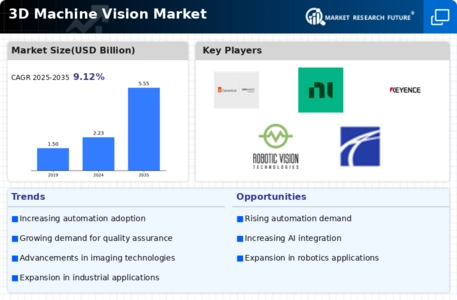Top Industry Leaders in the 3D Machine Vision Market

Competitive Landscape of 3D Machine Vision Market
The 3D machine vision market presents a dynamic landscape with established players jostling for position alongside nimble newcomers. Understanding the competitive landscape is crucial for stakeholders seeking to navigate this rapidly evolving market. This report delves into the current state of the market, highlighting key players, their strategies, and factors influencing market share. Additionally, it sheds light on emerging companies and current investment trends.
Key Players:
- OMRON Corporation (Japan)
- Canon Inc. (Japan)
- Cognex Corporation (US)
- National Instruments (US)
- Keyence Corporation (Japan)
- Robotic Vision Technologies Inc. (US)
- Sony Corporation (Japan)
- Coherent Inc. (US)
- Hermary Opto Electronics Inc. (Canada)
- Basler AG (Germany)
Strategies Adopted by Key Players:
- Product Innovation: Key players are investing heavily in research and development to create advanced 3D vision sensors, software, and solutions. This includes exploring new technologies like time-of-flight (ToF) and structured light illumination.
- Strategic Partnerships: Collaborations between sensor manufacturers and software developers are becoming increasingly common. These partnerships leverage complementary expertise to create integrated solutions catering to specific applications.
- Vertical Market Focus: Companies are tailoring their offerings to specific industries like automotive, electronics, and food & beverage. This involves developing industry-specific solutions and partnering with technology providers catering to these industries.
- Global Expansion: Leading players are expanding their global reach through strategic acquisitions and partnerships. This enables them to tap into new markets and cater to geographically dispersed customers.
Factors Influencing Market Share Analysis:
- Brand Reputation: Established players with a proven track record and strong brand reputation enjoy a significant advantage in market share.
- Technology Portfolio: Companies offering a comprehensive range of 3D vision sensors, software, and solutions catering to diverse applications are more likely to gain market share.
- Price Competitiveness: Balancing price with product quality and features is crucial for attracting customers, particularly in cost-sensitive industries.
- Customer Service: Providing excellent customer service, including training, support, and maintenance, fosters customer loyalty and contributes to market share growth.
- Compliance with Industry Standards: Adherence to relevant industry standards ensures product quality and interoperability with other automation equipment, enhancing market acceptance.
New and Emerging Companies:
Several new entrants are disrupting the 3D machine vision market with innovative solutions and competitive pricing. These companies often leverage cutting-edge technologies and focus on specific niche applications. Some notable examples include:
- Deepomatic: Provides AI-powered 3D vision solutions for industrial applications.
- TriVision Systems: Offers 3D vision solutions specifically designed for bin picking and robot guidance.
- Perceptron: Develops 3D vision sensors and software for autonomous mobile robots.
- ZED Technologies: Offers a 3D vision camera and software development kit for robotics and AR/VR applications.
- Orbbec 3D Technology: Focuses on 3D vision sensors and software for consumer electronics and industrial automation.
Current Company Investment Trends:
Investment in the 3D machine vision market is on the rise, driven by its promising growth prospects. Companies are focusing on the following areas:
- AI integration: Integrating AI with 3D vision sensors and software enables real-time data analysis and automated decision-making.
- Deep learning algorithms: Developing deep learning algorithms enhances the accuracy and performance of 3D vision systems.
- Edge computing: Deploying 3D vision solutions at the edge reduces latency and improves data security.
- Cloud-based solutions: Offering cloud-based 3D vision solutions provides scalability and accessibility to a wider range of users.
- Industry-specific solutions: Developing specialized 3D vision solutions tailored to the unique needs of specific industries.
Latest Company Updates:
May 2023 - Delta, an outstanding industrial automation solutions and power management provider will soon come up with a high-speed DMV-T ToF (time of flight) smart camera at Hannover Messe later this year. Along with offering high capture speed of about 60 frames/second, this 3D camera it also offers large scanning distance of about up to six meters and also is the foremost software-defined 3D ToF camera. With a strong in-built processor and sophisticated DIAVision software platform, enables the system integrator in developing their algorithm in the DMV-T for creating their respective smart applications. This is ideal for the logistics warehouse automation industry. The delta DMV-T time of flight cameras allows precise 3D machine vision for the smart applications.
Due to the quick development of industrial automation, they are experiencing more customers in adopting machine vision for object detection, robotic guidance, and inspection and also edge safety applications. Transitioning to the 3D, examining that the majority of the applications required being done with an additional industrial PC to process. For minimizing investment yet maximizing the flexibility of application, DMV-T integrates dedicated processor & introduce the DIAVision platform for bringing the hardware to another intelligent level. Besides, in comparison to LiDAR, the DMV-T helps in capturing a wider image range that works wonders in enhancing the capability of the AGV for sensing and avoiding obstacle in the logistics industry. Further, operators and integrators can develop applications which run itself on the camera, cutting down the components which require being installed inside the other equipment & saving space.

